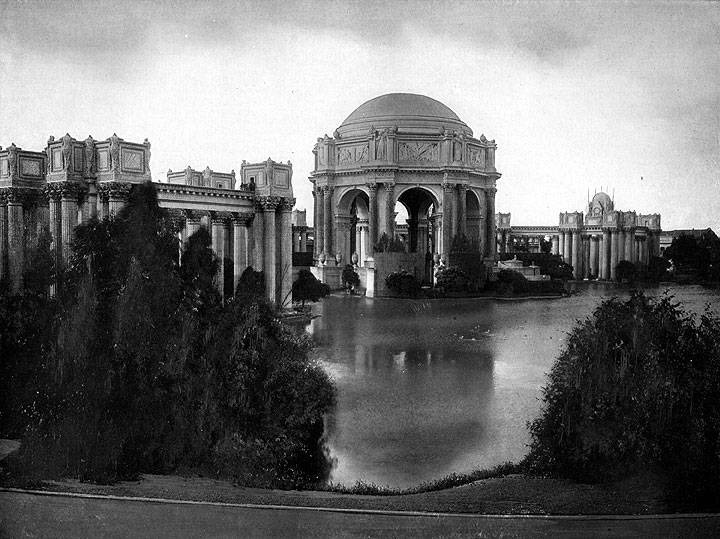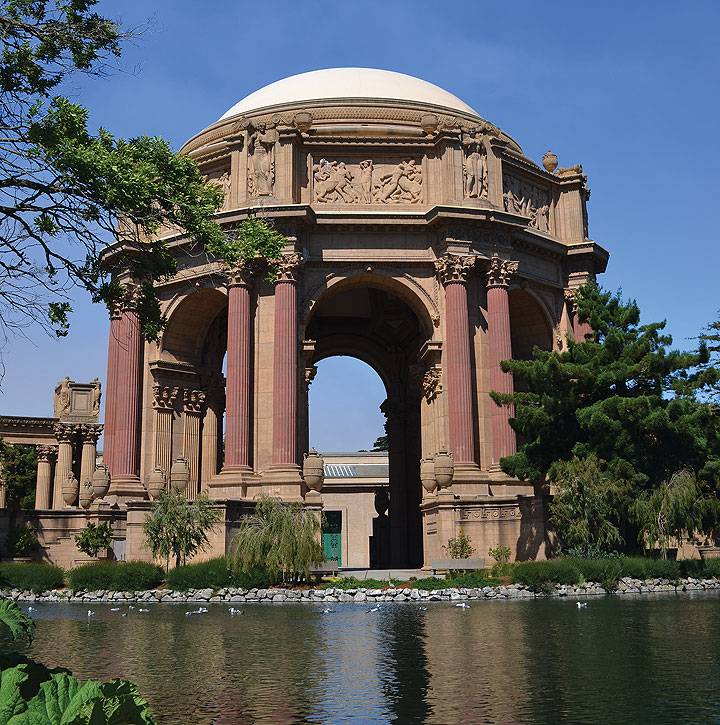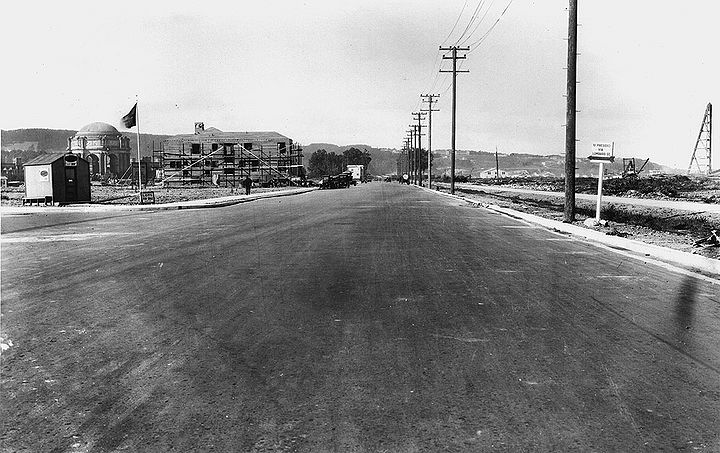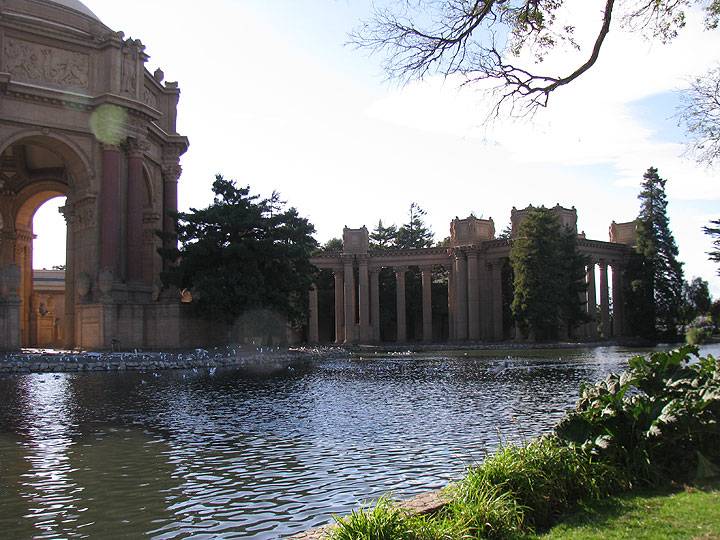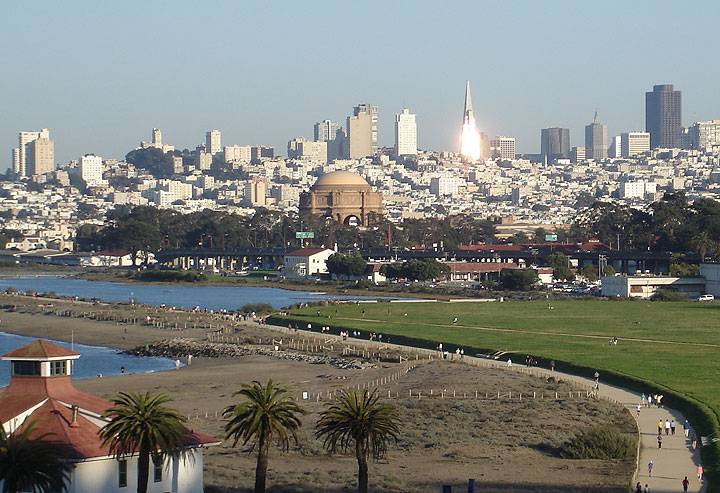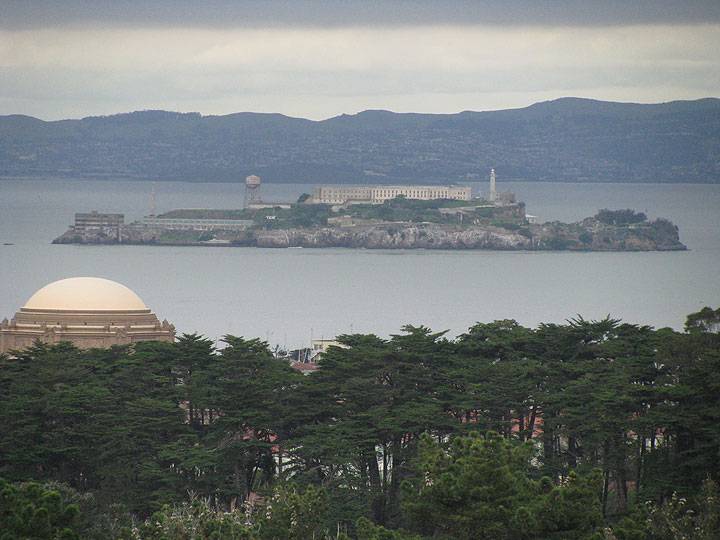The Palace of Fine Arts: Difference between revisions
m (1 revision(s)) |
(added new photos) |
||
| (9 intermediate revisions by 2 users not shown) | |||
| Line 1: | Line 1: | ||
'''<font face = Papyrus> <font color = maroon> <font size = 4>Historical Essay</font></font> </font>''' | |||
'' | ''by Gray Brechin, from "Sailing to Byzantium: The Architecture of the Fair" in ''The Anthroplogy of World's Fairs'', edited by Burton Benedict)'' | ||
[[Image:Palace-of-fine-arts-bw-1915.jpg]] | |||
The | '''The Palace of Fine Arts, 1915, soon after its construction.''' | ||
''I think the main building should be torn down and redwoods planted around--completely around--the rotunda.... As they grow, the columns would slowly crumble at approximately the same speed. Then I would like to design an altar, with the figure of a maiden praying, to install in that grove of redwoods.... I should like my palace to die behind those great trees of its own accord, and become its own cemetery''.31 | ''Photo: Shaping San Francisco'' | ||
[[Image:Palace-of-Fine-Arts Art-Peterson.jpg]] | |||
'''Palace of Fine Arts, [[PFA 1919|last remnant]] of the Panama-Pacific International Exposition of 1915, a world's fair to show the world that San Francisco had completely recovered from the 1906 Earthquake and fire.''' | |||
''Photo: Art Peterson'' | |||
{| style="color: black; background-color: #F5DA81;" | |||
| colspan="2" | '''A collection of contemporary reactions to and descriptions of Bernard Maybeck’s Palace of Fine Arts, which is one of the Panama Pacific International Exhibition’s few surviving structures. Additionally, Gray Brechin describes Maybeck’s initial plan for the Exhibition, which would have included a mirroring structure called the Peace Palace.''' | |||
|} | |||
Rivaled only by Mullgardt's Court of the Ages, the Palace of Fine Arts was the most beloved building at the [[SAILING TO BYZANTIUM: 1915 Panama Pacific International Exposition |fair]], its superbly evocative beauty saving it from ultimate demolition. While the rest of the fair may have seemed an artifice of eternity, Maybeck's Palace drew much of its success from a melancholic celebration of the transitory. Frank Morton Todd wrote that "it represented the beauty and grandeur of the past. A cloister enclosing nothing, a colonnade without a roof, stairs that ended nowhere, a fane with a lonely votary kneeling at a dying flame, fluted shafts that rose, half hid in vines, from the lush growth of an old swamp. . . . "(27) The elegiacal theme was, Todd also noted, inspired by Arnold Bocklin's moody painting "The Isle of the Dead," while the vocabulary of ruin is clearly taken from the visionary etchings of Piranesi. The melancholic theme-emphasized by the dark and irregular reflecting lagoon, the weeping maidens guarding caskets on the peristyle (meant to hold trees), and the intentional overgrowth that once sprang from monumental planter boxes--is meant to express the sadness that both the artist and the viewer feel for the inability of even the greatest art to reach perfection.(28) | |||
The Palace was universally admired, despite the shocking liberties it took with the classical orders. Professor van Noppen of Columbia remarked that "the Palace of Fine Arts is so sublime, so majestic, and is the product of such imagination that it would have graced the age of Pericles,"(29) while Thomas Edison exclaimed, The architect of that building is a genius. There is not the equal anywhere on earth."(30) In succeeding years, the Palace became exactly what its creator had intended, a vast and decadent ruin whose garish colors bleached to sunset tones of russet and ochre. Asked in old age what he felt should be done about the collapsing Palace, Maybeck characteristically responded: | |||
<blockquote>''I think the main building should be torn down and redwoods planted around--completely around--the rotunda.... As they grow, the columns would slowly crumble at approximately the same speed. Then I would like to design an altar, with the figure of a maiden praying, to install in that grove of redwoods.... I should like my palace to die behind those great trees of its own accord, and become its own cemetery''.(31) </blockquote> | |||
It appears that the Palace of Fine Arts was meant to complement another domed building to the south. Charcoal drawings in the Maybeck papers at Berkeley correspond to a "Peace Palace" that appears on the earliest block plans of the Panama Pacific International Exposition and for which Maybeck prepared advanced schematics. Drawings include elevations, perspectives, and plans of a central-plan Palladian villa on a high arcaded podium connected to the Fine Arts lagoon by an axial pool in a sunken garden. The earliest plans for the Palace of Fine Arts, in fact, show a rectilinear, rather than naturalistic, lagoon extending south toward the projected Peace Palace. The sunken garden itself, it appears, would have been enclosed by John McLaren's living walls (flats of South African iceplant stacked vertically) to create a curious combination of Baroque formality and ruinous overgrowth. The building, probably meant to echo the Peace Palace then being built with Andrew Carnegie's funds in The Hague, was apparently scrapped at an early date for reasons of economy and replaced by a huge revenue-producing hotel, the Inside Inn. | It appears that the Palace of Fine Arts was meant to complement another domed building to the south. Charcoal drawings in the Maybeck papers at Berkeley correspond to a "Peace Palace" that appears on the earliest block plans of the Panama Pacific International Exposition and for which Maybeck prepared advanced schematics. Drawings include elevations, perspectives, and plans of a central-plan Palladian villa on a high arcaded podium connected to the Fine Arts lagoon by an axial pool in a sunken garden. The earliest plans for the Palace of Fine Arts, in fact, show a rectilinear, rather than naturalistic, lagoon extending south toward the projected Peace Palace. The sunken garden itself, it appears, would have been enclosed by John McLaren's living walls (flats of South African iceplant stacked vertically) to create a curious combination of Baroque formality and ruinous overgrowth. The building, probably meant to echo the Peace Palace then being built with Andrew Carnegie's funds in The Hague, was apparently scrapped at an early date for reasons of economy and replaced by a huge revenue-producing hotel, the Inside Inn. | ||
[[Image:Marina-Blvd-west-towards-Palace-of-Fine-Arts-March-6-1925-SFDPW.jpg|720px]] | |||
'''Marina Boulevard looking west towards Palace of Fine Arts, March 6, 1925.''' | |||
''Photo: SFDPW, courtesy Charles Ruiz collection'' | |||
[[Image:Palace-of-Fine-Arts 9000.jpg]] | |||
'' | '''Palace of Fine Arts''' | ||
Carlsson | ''Photo: Chris Carlsson'' | ||
[[Image:Palace-of-Fine-Arts-w-sun-hitting-Pyramid-in-background 8050.jpg]] | |||
'''Palace of Fine Arts sitting between a sun-emblazoned Pyramid downtown and the bucolic, restored [[Crissy Field Tidal Marsh|Crissy Field and marsh]] in the foreground, 2009.''' | |||
''Photo: Chris Carlsson'' | |||
[[Image:Palace-of-Fine-Arts-and-Alcatraz 5000.jpg]] | |||
'''Palace of Fine Arts roof punctuates view from Inspiration Point northeasterly towards [[The Unselling of Alcatraz|Alcatraz]] and beyond.''' | |||
''Photo: Chris Carlsson'' | |||
[[Destruction of the Fair|Footnotes]] | |||
[[Pacific Heights View |Prev. Document]] [[SAILING TO BYZANTIUM: 1915 Panama Pacific International Exposition |Next Document]] | [[Pacific Heights View |Prev. Document]] [[SAILING TO BYZANTIUM: 1915 Panama Pacific International Exposition |Next Document]] | ||
[[category:Marina]] [[category:Fairs]] [[category:Amusement Parks]] [[category:1910s]] [[category:architecture]] [[category:Buildings]] [[category:1990s]] | |||
Latest revision as of 16:46, 13 October 2014
Historical Essay
by Gray Brechin, from "Sailing to Byzantium: The Architecture of the Fair" in The Anthroplogy of World's Fairs, edited by Burton Benedict)
The Palace of Fine Arts, 1915, soon after its construction.
Photo: Shaping San Francisco
Palace of Fine Arts, last remnant of the Panama-Pacific International Exposition of 1915, a world's fair to show the world that San Francisco had completely recovered from the 1906 Earthquake and fire.
Photo: Art Peterson
| A collection of contemporary reactions to and descriptions of Bernard Maybeck’s Palace of Fine Arts, which is one of the Panama Pacific International Exhibition’s few surviving structures. Additionally, Gray Brechin describes Maybeck’s initial plan for the Exhibition, which would have included a mirroring structure called the Peace Palace. |
Rivaled only by Mullgardt's Court of the Ages, the Palace of Fine Arts was the most beloved building at the fair, its superbly evocative beauty saving it from ultimate demolition. While the rest of the fair may have seemed an artifice of eternity, Maybeck's Palace drew much of its success from a melancholic celebration of the transitory. Frank Morton Todd wrote that "it represented the beauty and grandeur of the past. A cloister enclosing nothing, a colonnade without a roof, stairs that ended nowhere, a fane with a lonely votary kneeling at a dying flame, fluted shafts that rose, half hid in vines, from the lush growth of an old swamp. . . . "(27) The elegiacal theme was, Todd also noted, inspired by Arnold Bocklin's moody painting "The Isle of the Dead," while the vocabulary of ruin is clearly taken from the visionary etchings of Piranesi. The melancholic theme-emphasized by the dark and irregular reflecting lagoon, the weeping maidens guarding caskets on the peristyle (meant to hold trees), and the intentional overgrowth that once sprang from monumental planter boxes--is meant to express the sadness that both the artist and the viewer feel for the inability of even the greatest art to reach perfection.(28)
The Palace was universally admired, despite the shocking liberties it took with the classical orders. Professor van Noppen of Columbia remarked that "the Palace of Fine Arts is so sublime, so majestic, and is the product of such imagination that it would have graced the age of Pericles,"(29) while Thomas Edison exclaimed, The architect of that building is a genius. There is not the equal anywhere on earth."(30) In succeeding years, the Palace became exactly what its creator had intended, a vast and decadent ruin whose garish colors bleached to sunset tones of russet and ochre. Asked in old age what he felt should be done about the collapsing Palace, Maybeck characteristically responded:
I think the main building should be torn down and redwoods planted around--completely around--the rotunda.... As they grow, the columns would slowly crumble at approximately the same speed. Then I would like to design an altar, with the figure of a maiden praying, to install in that grove of redwoods.... I should like my palace to die behind those great trees of its own accord, and become its own cemetery.(31)
It appears that the Palace of Fine Arts was meant to complement another domed building to the south. Charcoal drawings in the Maybeck papers at Berkeley correspond to a "Peace Palace" that appears on the earliest block plans of the Panama Pacific International Exposition and for which Maybeck prepared advanced schematics. Drawings include elevations, perspectives, and plans of a central-plan Palladian villa on a high arcaded podium connected to the Fine Arts lagoon by an axial pool in a sunken garden. The earliest plans for the Palace of Fine Arts, in fact, show a rectilinear, rather than naturalistic, lagoon extending south toward the projected Peace Palace. The sunken garden itself, it appears, would have been enclosed by John McLaren's living walls (flats of South African iceplant stacked vertically) to create a curious combination of Baroque formality and ruinous overgrowth. The building, probably meant to echo the Peace Palace then being built with Andrew Carnegie's funds in The Hague, was apparently scrapped at an early date for reasons of economy and replaced by a huge revenue-producing hotel, the Inside Inn.
Marina Boulevard looking west towards Palace of Fine Arts, March 6, 1925.
Photo: SFDPW, courtesy Charles Ruiz collection
Palace of Fine Arts
Photo: Chris Carlsson
Palace of Fine Arts sitting between a sun-emblazoned Pyramid downtown and the bucolic, restored Crissy Field and marsh in the foreground, 2009.
Photo: Chris Carlsson
Palace of Fine Arts roof punctuates view from Inspiration Point northeasterly towards Alcatraz and beyond.
Photo: Chris Carlsson

